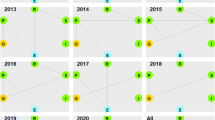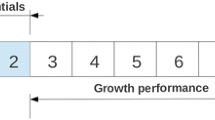Abstract
Firms grow and decline by relatively lumpy jumps which cannot be accounted by the cumulation of small, “atom-less”, independent shocks. Rather “big” episodes of expansion and contraction are relatively frequent. More technically, this is revealed by the fat-tailed distributions of growth rates. This applies across different levels of sectoral disaggregation, across countries, over different historical periods for which there are available data. What determines such property? In Dosi et al. (The footprint of evolutionary processes of learning and selection upon the statistical properties of industrial dynamics. Industrial and corporate change. Oxford University Press, Oxford, 2016) we implemented a simple multi-firm evolutionary simulation model, built upon the coupling of a replicator dynamic and an idiosyncratic learning process, which turns out to be able to robustly reproduce such a stylized fact. Here, we investigate, by means of a Kriging meta-model, how robust such “ubiquitousness” feature is with regard to a global exploration of the parameters space. The exercise confirms the high level of generality of the results in a statistically robust global sensitivity analysis framework.





Similar content being viewed by others
Notes
In the present case it may be more appropriate to call the choice of the sampling points in the parameters space as quasi-experiment, as the conditions imposed for selecting the observations for the sample are specified by the NOLH.
Here, we closely follow, whenever possible, the analytical framework employed by those authors and refer the readers to their paper for additional details and references.
The rescaled Beta distribution was preferred because of its superior flexibility in terms of parametrization and the bounded support. Other than Beta, Laplace and Gaussian, Log-normal and Poisson distributions were also tested in Dosi et al. (2016). Different distributions did not qualitatively affect the results.
The simulation model is coded in C++ and it is run inside the LSD simulation platform (Valente 2014) which is also employed for the NOLH sampling procedure, as explained below.
The parameter \(\mu \) of the distributions (Beta, Laplace, Gaussian) was chosen in order to produce an average innovation shock of 0.05 (or 5% increase in the productivity of adopted innovations). This value is loosely connected to the order of magnitude of advancements in process innovation for many industries. Similarly, \(\mu _{max}\) (0.20) represents an upper limit to the innovation process for distributions with infinite support (Laplace, Gaussian), also loosely based on empirical evidence. The remaining distributions’ parameters were set to keep at least 80% of the mass of the distributions below \(\mu _{max}\). The number of firms was chosen to be in line with empirical datasets when the analysis is done at 2–3 digits. The parameter A and \(\gamma \) were set to 1 arbitrarily. The initial size was set to 1 / N (all firms equal) with no loss of generality, as the model is ergodic (see Dosi et al. 2016) and initial conditions are not relevant for a sufficiently long time frame. Initial productivity is set to 1 as a reference.
Subbotin parameters estimation is performed by the maximum-likelihood method using the Subbotools package (Bottazzi 2014).
Second order polynomials with full interactions were evaluated but systematically produced meta-models with worse fitting than the original model, even when more samples are added to the DoE, as the interactions and nonlinearities are usually better modelled by the correlation function. The Kriging trend function coefficients are estimated using generalized least squares.
Definitions for other correlation function alternatives can be found in Roustant et al. (2012).
The Kriging correlation function (kernel) coefficients are estimated by means of numerical maximum likelihood. For the details on the technical implementation applied, see Roustant et al. (2012).
The technical feasibility criterion adopted was the minimally “normal” operation of the market, measured by the survival of at least two firms during the majority of simulation time steps. Also, some of the parameters’ test ranges limit, in practice, the possible ranges of variation for other parameters (e.g., the distribution average \(\mu \) must be lower than the upper support of distributions \(\mu _{max}\)).
Noise is used in the entire estimation process to evaluate observations. Samples under too much noise (sampling variance over 10 times the average) are discarded in the estimation process. Table 4 presents the effective number of observations used.
However, the \(Q^2\) statistic is not lower-bounded to zero, like the \(R^2\), being possibly negative in the case the model performs worse than the “no-model” estimate (the mean of the sample). To avoid confusion, we lower bounded the values of \(Q^2\) to zero.
The meta-model estimation (using GLS for the trend and numerical ML for the correlation function coefficients) and the following sensitivity analysis (using Sobol decomposition) was performed using the DiceKriging, DiceOptim and DiceEval packages (Roustant et al. 2012; Dupuy et al. 2015) in R (R Core Team 2016).
The Matèrn correlation function—the Fourier transform of the Student distribution density function—in its 5/2 formulation can be specified as (Rasmussen and Williams 2006):
$$\begin{aligned} {\text {corr}}(\delta (\mathbf {x}_i), \delta (\mathbf {x}_j)) = \left( 1 + \sqrt{5} h + \frac{5}{3} h^2 \right) \exp \left( - \sqrt{5} h \right) , \quad h = \sum _{g=1}^{k} \psi _g |x_{g,i}-x_{g,j}|. \end{aligned}$$(11)One may question how such non-linear interactions can be captured if the employed Kriging trend function is a polynomial of order zero or one. The answer is to be found on the Kriging correlation function as the role of interactions was excluded only in the global trend. Note, instead, that the correlation function does capture the interactions among the parameters, which are indeed stochastic (spatial correlation) and not deterministic.
Kriging predictions becomes more precise as the interpolated point gets closer to one of the DoE points, where the error of the model is always zero by construction—and vice versa—so \(\epsilon \) is not constant.
References
Bargigli L, Riccetti L, Russo A, Gallegati M (2016) Network calibration and metamodeling of a financial accelerator agent based model. ssrn
Bottazzi G (2014) SUBBOTOOLS. Scuola Superiore Sant’Anna, Pisa
Bottazzi G, Secchi A (2003) A stochastic model of firm growth. Phys A Stat Mech Appl 324(1):213–219
Bottazzi G, Secchi A (2006) Explaining the distribution of firm growth rates. RAND J Econ 37(2):235–256
Bottazzi G, Cefis E, Dosi G (2002) Corporate growth and industrial structures: some evidence from the italian manufacturing industry. Indus Corp Change 11(4):705–723
Cioppa T, Lucas T (2007) Efficient nearly orthogonal and space-filling latin hypercubes. Technometrics 49(1):45–55
Dosi G (2007) Statistical regularities in the evolution of industries. A guide trough some evidence and challenges for the theory. In: Malerba F, Brusoni S (eds) Perspectives on innovation (2007), Cambridge University Press, Cambridge
Dosi G, Marsili O, Orsenigo L, Salvatore R (1995) Learning, market selection and the evolution of industrial structures. Small Bus Econ 7(6):411–436
Dosi G, Nelson R, Winter S (2000) The nature and dynamics of organizational capabilities. Oxford University Press, Oxford
Dosi G, Pereira M, Virgillito M (2016) The footprint of evolutionary processes of learning and selection upon the statistical properties of industrial dynamics. Industrial and corporate change. Oxford University Press, Oxford. doi:10.1093/icc/dtw044
Dupuy D, Helbert C, Franco J (2015) DiceDesign and DiceEval: two R packages for design and analysis of computer experiments. J Stat Softw 65(11):1–38
Helton J, Johnson J, Sallaberry C, Storlie C (2006) Survey of sampling-based methods for uncertainty and sensitivity analysis. Reliab Eng Syst Saf 91(10):1175–1209
Ijiri Y, Simon H (1977) Skew distributions and the sizes of business firms. North-Holland, Amsterdam
Iooss B, Boussouf L, Feuillard V, Marrel A (2010) Numerical studies of the metamodel fitting and validation processes. arXiv preprint arXiv:1001.1049
Jeong S, Murayama M, Yamamoto K (2005) Efficient optimization design method using kriging model. J Aircr 42(2):413–420
Kleijnen JP (2009) Kriging metamodeling in simulation: a review. Eur J Oper Res 192(3):707–716
Kleijnen J, Sargent R (2000) A methodology for fitting and validating metamodels in simulation. Eur J Oper Res 120(1):14–29
Krige D (1951) A statistical approach to some basic mine valuation problems on the witwatersrand. J Chem Metall Min Soc S Afr 52(6):119–139
Matheron G (1963) Principles of geostatistics. Econ Geol 58(8):1246–1266
McKay M, Beckman R, Conover W (2000) A comparison of three methods for selecting values of input variables in the analysis of output from a computer code. Technometrics 42(1):55–61
Metcalfe JS (1998) Evolutionary economics and creative destruction. Routledge & Kegan Paul, London
Nelson RR, Winter SG (1982) An evolutionary theory of economic change. Belknap Press of Harvard University Press, Cambridge
R Core Team (2016) R: a language and environment for statistical computing. R Foundation for Statistical Computing, Vienna
Rasmussen C, Williams C (2006) Gaussian processes for machine learning. MIT Press, Cambridge
Roustant O, Ginsbourger D, Deville Y (2012) Dicekriging, diceoptim: two R packages for the analysis of computer experiments by kriging-based metamodeling and optimization. J Stat Softw 51(1):1–55
Salle I, Yildizoglu M (2014) Efficient sampling and meta-modeling for computational economic models. Comput Econ 44(4):507–536
Saltelli A, Annoni P (2010) How to avoid a perfunctory sensitivity analysis. Environ Model Softw 25(12):1508–1517
Saltelli A, Tarantola S, Campolongo F (2000) Sensitivity analysis as an ingredient of modeling. Stat Sci 15(4):377–395
Saltelli A, Ratto M, Andres T, Campolongo F, Cariboni J, Gatelli D, Saisana M, Tarantola S (2008) Global sensitivity analysis: the primer. Wiley, New York
Schumpeter J (1947) Capitalism, socialism, and democracy. Harper & Brothers Publishers, New York and London
Silverberg G, Dosi G, Orsenigo L (1988) Innovation, diversity and diffusion: a self-organisation model. Econ J 98(393):1032–1054
Valente M (2014) LSD: laboratory for simulation development. University of L’Aquila, L’Aquila
Van Beers W, Kleijnen J (2004) Kriging interpolation in simulation: a survey. In: Proceedings of the 2004 Winter Simulation Conference, 2004. IEEE, vol 1
Wang G, Shan S (2007) Review of metamodeling techniques in support of engineering design optimization. J Mech Des 129(4):370–380
Acknowledgements
We thank Francesca Chiaromonte for helpful comments and discussions. We gratefully acknowledge the support by the European Union’s Horizon 2020 research and innovation programme under grant agreement No. 649186 - ISIGrowth and by Fundação de Amparo à Pesquisa do Estado de São Paulo (FAPESP), process No. 2015/09760-3.
Author information
Authors and Affiliations
Corresponding author
Rights and permissions
About this article
Cite this article
Dosi, G., Pereira, M.C. & Virgillito, M.E. On the robustness of the fat-tailed distribution of firm growth rates: a global sensitivity analysis. J Econ Interact Coord 13, 173–193 (2018). https://doi.org/10.1007/s11403-017-0193-4
Received:
Accepted:
Published:
Issue Date:
DOI: https://doi.org/10.1007/s11403-017-0193-4
Keywords
- Fat-tailed distributions
- Kriging meta-modeling
- Near-orthogonal latin hypercubes
- Variance-based sensitivity analysis
- ABMs validation




